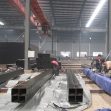How to look at air tightness of curtain wall buildings
The Air Tightness Testing and Measurement Association (ATTMA) define ‘air leakage’ as “uncontrolled flow of air through gaps and cracks in a building fabric. It is sometimes known as infiltration or draughts. Air leakage is not to be confused with ventilation, which is controlled airflow in and out of a building.
In general, curtain wall system is regarded the ‘barriers on the outer skin of a building, for separating interior space from the exterior environment. In other words, curtain wall is a nonstructural exterior covering of a building that is connected to the frame and used to withstand the effects of environmental elements that includes wind, rain, etc. In that regard, it is very important to carefully study the curtain wall during the design stage to take into consideration all of the performance criteria such as air and water tightness. The selection of the right material and the design elements for the curtain wall are very critical to give longer life to the building. In addition, in summer, infiltration can bring humid, outdoor air into buildings. In winter, exfiltration can result in moist indoor air moving into cold wall cavities and can result in condensation and ultimately mould or rot. In that regard, good air tightness performance is considered one of the intrinsic building envelope functions which can be defined as the resistance of inward or outward air leakage through unintentional openings for a curtain wall building. Airtight envelope has several pros in thermal efficiency and comfort which affect substantially in energy savings as well as HVAC equipment capacities as well. Due to moisture, the mold could be reduced especially in coastal regions if the facade achieves airtightness standard. In the case of clustered high-rise buildings, the wind tunnel effect must be considered to avoid a negative impact on air leakage and structural failure and stability too.
As air infiltration is not desirable, it is very important to have sufficient purpose-provided ventilation for high-rise buildings as much as possible. According to the Building Services Research and Information Association (BSRIA), project teams should try to design and construct the building fabric to be reasonably airtight as well as provide natural or mechanical ventilation systems to maintain good indoor air quality while minimising energy use in curtain wall construction. There are a few benefits of using air-tight buildings including:
•Lower running costs through reduced heat loss.
•Fewer defects.
•Reduced condensation.
•Improved comfort.
•Reduced carbon emissions.
•Verification of build quality.
Dong Peng Bo Da Steel Pipe Group is a famous steel pipe manufacturer in China. We are committed to producing various types of steel products for your choice in your building project in future. Our products are all designed for the fast and easy installation of curtain walls. Contact us if you have any need in your project.
Tel: +86 18202256900 Email: steel@fwssteel.com










